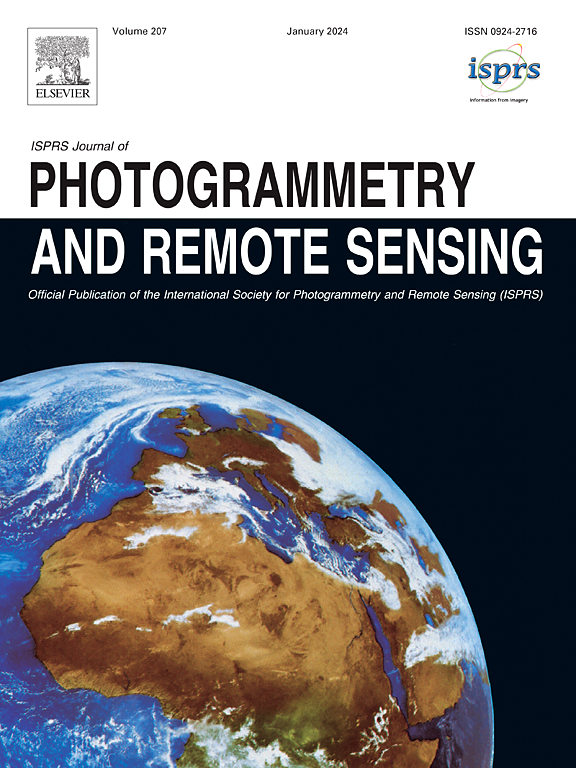Cloud-based satellite remote sensing for enhancing seagrass monitoring and ecosystem management
IF 12.2
1区 地球科学
Q1 GEOGRAPHY, PHYSICAL
ISPRS Journal of Photogrammetry and Remote Sensing
Pub Date : 2025-06-28
DOI:10.1016/j.isprsjprs.2025.06.034
引用次数: 0
Abstract
We examined the feasibility of monitoring interannual and intra-annual changes in seagrass extent in Tampa Bay, Florida between 1987 and 2023 using remote sensing with the Landsat 5, Landsat 7, Landsat 8, and Sentinel-2 satellite sensor series. This study filled gaps and extended the time series developed for the period 1990–2021 by Lizcano-Sandoval et al. (2022). Seagrass extent was evaluated for six Tampa Bay segments: Hillsborough Bay (HB), Old Tampa Bay (OTB), Middle Tampa Bay (MTB), Lower Tampa Bay (LTB), Boca Ciega Bay (BCB), Manatee River + Terra Ceia Bay (MRTC). Results were compared with reference data from the biennial mapping program conducted by the Southwest Florida Water Management District (SWFWMD). Overall, seagrass showed long-term increases in extent in Tampa Bay. The highest increasing rates over 1987–2023 were observed in HB (+5.7 % yr−1) and OTB (+3.5 % yr−1). Smaller increases were observed in BCB (0.9 % yr−1). However, in HB and MRTC seagrass extent showed decreases in particular years between 2015 and 2023 (34 % and 11 %, respectively), and in OTB between 2017 and 2023 (41 %). Intra-annual changes in seagrass extent were observed during 2021–2023. Intra-annual coefficient of variation was estimated to be as low as 3 % in BCB and as high as 60 % in HB. Seagrass extent estimated by remote sensing was highly correlated with the reference data (r > 0.74), except in the MRTC segment (r = -0.29). A Google Earth Engine app was developed to allow public access to the temporal and spatial changes of seagrass extent and distribution in Tampa Bay. The results showed that seagrass extent assessments to complement existing field and airborne seagrass monitoring programs are feasible at low cost with public satellite imagery in the cloud.

基于云的卫星遥感加强海草监测和生态系统管理
利用Landsat 5、Landsat 7、Landsat 8和Sentinel-2卫星系列遥感技术,研究了1987 - 2023年美国佛罗里达州坦帕湾海草面积年际和年内变化的可行性。本研究填补了Lizcano-Sandoval等人(2022)在1990-2021年期间开发的时间序列的空白,并对其进行了扩展。对6个坦帕湾段:希尔斯伯勒湾(HB)、老坦帕湾(OTB)、中坦帕湾(MTB)、下坦帕湾(LTB)、博卡西加湾(BCB)、海牛河+ Terra Ceia湾(MRTC)进行海草范围评估。结果与西南佛罗里达水管理区(SWFWMD)两年一次的测绘计划的参考数据进行了比较。总体而言,坦帕湾海草的范围长期增加。1987-2023年期间,HB(+ 5.7% - 1年)和OTB(+ 3.5% - 1年)的增长率最高。BCB的增加较小(0.9% yr - 1)。然而,HB和MRTC的海草范围在2015年至2023年之间的特定年份有所减少(分别为34%和11%),而OTB在2017年至2023年之间(41%)。在2021-2023年期间,观察了海草面积的年内变化。年内变异系数估计在BCB中低至3%,在HB中高达60%。遥感估算的海草面积与参考数据高度相关(r >;0.74), MRTC段除外(r = -0.29)。开发了谷歌Earth Engine应用程序,允许公众访问坦帕湾海草范围和分布的时空变化。结果表明,利用云中公共卫星图像进行海草范围评估以补充现有的野外和空中海草监测计划是可行的,而且成本低。
本文章由计算机程序翻译,如有差异,请以英文原文为准。
求助全文
约1分钟内获得全文
求助全文
来源期刊

ISPRS Journal of Photogrammetry and Remote Sensing
工程技术-成像科学与照相技术
CiteScore
21.00
自引率
6.30%
发文量
273
审稿时长
40 days
期刊介绍:
The ISPRS Journal of Photogrammetry and Remote Sensing (P&RS) serves as the official journal of the International Society for Photogrammetry and Remote Sensing (ISPRS). It acts as a platform for scientists and professionals worldwide who are involved in various disciplines that utilize photogrammetry, remote sensing, spatial information systems, computer vision, and related fields. The journal aims to facilitate communication and dissemination of advancements in these disciplines, while also acting as a comprehensive source of reference and archive.
P&RS endeavors to publish high-quality, peer-reviewed research papers that are preferably original and have not been published before. These papers can cover scientific/research, technological development, or application/practical aspects. Additionally, the journal welcomes papers that are based on presentations from ISPRS meetings, as long as they are considered significant contributions to the aforementioned fields.
In particular, P&RS encourages the submission of papers that are of broad scientific interest, showcase innovative applications (especially in emerging fields), have an interdisciplinary focus, discuss topics that have received limited attention in P&RS or related journals, or explore new directions in scientific or professional realms. It is preferred that theoretical papers include practical applications, while papers focusing on systems and applications should include a theoretical background.
 求助内容:
求助内容: 应助结果提醒方式:
应助结果提醒方式:


